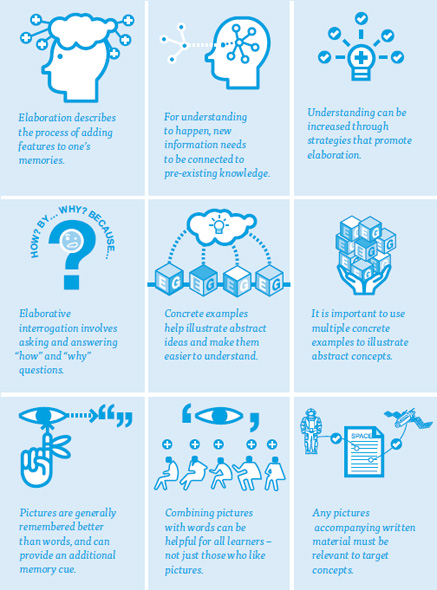

As teachers, we hope that our students will learn material in a meaningful manner – that is, that they will understand it. Understanding occurs when students elaborate a memory by adding details to it and integrating it with existing knowledge, and can be enhanced by several effective strategies.
Elaboration is one of the most frequently discussed concepts among memory researchers (Smith, 2014). Likely one of the reasons elaboration is discussed at length is that the term is very broad and can mean a lot of different things. In the simplest terms, elaboration means to add something to a memory (see Hirshman, 2001; Postman, 1976).
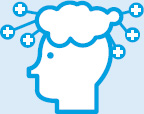
Elaboration describes the process of adding features to one’s memories.
Elaboration is also thought to encourage organization, or the connecting and integrating of ideas (Bellezza, Cheesman, & Reddy, 1977; Mandler, 1979). When new information is integrated and organized with information that was already known, this process makes it easier to remember the new information later on.
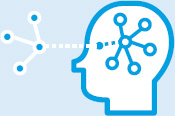
For understanding to happen, new information needs to be connected to pre-existing knowledge.
Another way of defining elaboration is to think about information on a deeper level (Craik & Lockhart, 1972; Craik & Tulving, 1975). The idea is that information can be processed at various levels. Shallow processing involves analyzing information with regard to surface details, such as indicating whether a word is written in all capital letters or whether its font is bold. Deeper processing involves thinking about the meaning of the word. Thinking deeply about meaning is thought to induce elaboration. According to this framework, one remembers information better if it is processed more deeply compared to when it is processed in a shallow manner.
Elaboration is thought to be one of the best ways to increase learning and memory among many memory theorists. For example, in 1983, Anderson said, “one of the most potent manipulations that can be performed in terms of increasing a subject’s memory for material is to have the subject elaborate on the to-be-remembered material” (p. 285). If that is true, then all we as educators need to do is make sure that students are elaborating, and then they should maximize their learning! If only it were that simple.

 When semantic (deeper level) questions were asked about a presented word, its subsequent retention was greatly enhanced. (1975, p. 278)
When semantic (deeper level) questions were asked about a presented word, its subsequent retention was greatly enhanced. (1975, p. 278)

Fergus Craik & Endel Tulving
We have spent a lot of time thinking about the idea of elaboration. (In fact, Megan’s entire doctoral dissertation was all about elaboration and retrieval!) From our perspective, the idea of elaboration is so broad that it can become difficult to use in practice. Additions to memory can mean almost anything. Even more problematic is that the term has become somewhat circular: when a process is found to improve learning and memory we attribute this to elaboration, but if a process does not improve learning and memory then we conclude elaboration did not occur, or did not occur enough (Karpicke & Smith, 2012).
The term elaboration itself may be too broad to utilize effectively in educational settings. However, there are three specific techniques – elaborative interrogation, concrete examples, and dual coding – that have shown promise in improving student learning and helping students understand the material they are learning.

Understanding can be increased through strategies that promote elaboration.
Elaborative interrogation is a specific method of elaboration where you ask yourself questions about how and why things work, and then produce the answers to those questions (McDaniel & Donnelly, 1996; Pressley, McDaniel, Turnure, Wood, & Ahmad, 1987). The specific questions to ask will depend, in part, on the learning topic at hand. Below are some examples from two different topics: neural communication, and the attack on Pearl Harbor.
How does neural communication work? Well, if we look at one neuron, the dendrites receive messages from many other neurons, and then the messages converge in the soma. If there is enough of a positive charge within the soma, then an action potential will occur, and an electrical signal is sent down the axon. When the signal reaches the terminal buttons, neurotransmitters are released into the synapse where they communicate with the dendrites of the next neuron.

Elaborative interrogation involves asking and answering “how” and “why” questions.
Why does this happen? The neurotransmitters are chemicals that allow neurons to communicate with one another. Overall, the pattern of activation among different neurons (which neurons fire, how quickly, what neurotransmitters they release) determines the message in your brain.
How does the axon work? The axon is a long tail-like structure that produces the electrical signal.
How does the signal travel? The axon is covered in myelin sheath, a fatty substance that insulates the axon. The myelin sheath works like the rubber around the cord of an electrical appliance, and it serves to make the electricity travel faster.
Why have myelin sheath? Because we need our neurons to be able to send signals quickly, since we need to be able to react quickly, make decisions quickly, move quickly, perceive feeling in our skin quickly, etc.
How did this attack happen? On December 7, 1941, the Imperial Japanese Navy attacked the United States Naval Base at Pearl Harbor. The attack included Japanese fighter planes, bombers, and torpedo planes.
Why did this happen? The Japanese intended to destroy the United States’ Pacific Fleet so that it could not interfere with Japanese operations.
What was the result of this historic event? Well, Japanese casualties were light, while they damaged eight U.S. Navy battleships. The Arizona was among those that the Japanese sunk, and was not raised from the shallow water. U.S. aircraft were also destroyed, and 2,403 Americans were killed (1,178 were injured).
Why is this event important? The day after the attack, Roosevelt delivered his Infamy Speech, the United States formally declared war on Japan, and Japanese-Americans were then relocated to internment camps.
You could then go on: how did the U.S. enter the war? How did the Pearl Harbor attack lead up to the release of the atomic bomb? How did the war end? And so on.
The main goal is to ask a number of questions that encourage you (or your students) to explain the main concepts. As you are elaborating, you are making connections between old and new knowledge, making the memories easier to retrieve later. Of course, these questions are just example questions, and there are a lot of different questions one could ask. The important thing is that the questions lead to describing and explaining the main ideas, and making connections between various ideas.
This process of generating elaborative questions and finding the answers to them has been shown to be better for student learning than simply reading the information, and even having students select their own study strategies. For example, Woloshyn and Stockley (1995) had 6th and 7th grade students learn science facts that were consistent with their prior knowledge and facts that were inconsistent with their prior knowledge.
An example of a consistent or unsurprising science fact from their research is “the larger an animal is, the more oxygen it needs to live.” But take, for example, this fact: “the sun is made up of every color, including blue and violet.” This type of fact might be more surprising to students. The study looked at how elaborative interrogation impacted learning of both types of facts. The students worked either independently, or in pairs – and in one of three learning conditions: elaborative interrogation, students’ own strategy, and reading aloud (see over for a graphic with more details on each condition).

Vera Woloshyn
Learning was assessed both immediately and 60 days after the study session. Studying in pairs versus independently did not make a difference to later learning, but students who practiced elaborative interrogation learned more than those in the other two learning conditions. This was true both for facts that were consistent and those that were inconsistent with prior knowledge. Importantly, this learning was durable – 60 days after the study session, students who practiced elaborative interrogation still performed best.
It’s interesting to note that students who selected their own study strategy did not do any better than those who just read for understanding. Thus, students were better able to understand and remember the facts, even if they were inconsistent with their prior beliefs, when they used elaborative interrogation compared to other learning strategies. Importantly, these findings demonstrate another point about elaborative interrogation: it is a flexible strategy because students can do this both on their own and in groups (see also Kahl & Woloshyn, 1994).
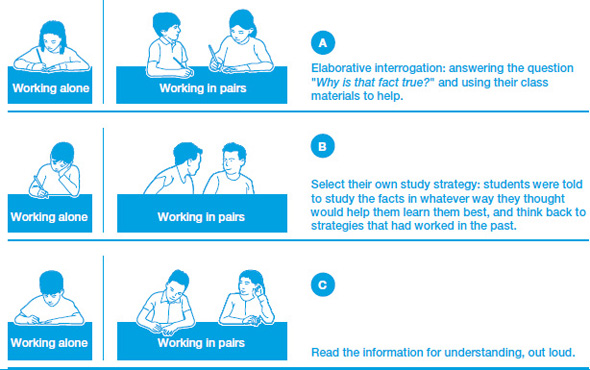
Learning conditions in Woloshyn and Stockley’s (1995) elaboration study.
There was one important caveat to the findings from Woloshyn and Stockley’s research: the quality of the elaborative interrogation answers mattered. Students performed best when they produced an adequate response to the question. However, producing an “inadequate” response was still better than providing no response at all. And finally, studying in pairs did not lead to a larger number of adequate responses than did studying alone.
Other research, however, has shown that when background knowledge on the topic is low, elaborative interrogation does not help as much as when the students have high background knowledge (Woloshyn, Pressley, & Schneider, 1992). And in some cases where the quality of the elaborations produced is really poor, this process can actually hurt learning compared to additional reading (Clinton, Alibali, & Nathan, 2016). For these reasons, elaborative interrogation is best utilized by teachers to help develop understanding, not necessarily when first introducing a topic.
Not many studies have yet taken the elaborative interrogation method out of the lab and into the classroom (see Chapter 2 for the lab-to-classroom model). The one classroom study we know about, however, did find encouraging results. In this study (Smith, Holliday, & Austin, 2010), almost 300 undergraduates enrolled in a biology course were randomly assigned to re-read or answer “why” questions about information that they were studying as part of their class. The authors found a small but significant advantage for the elaborative interrogation group compared to the re-reading group, and they found this even when they controlled for prior knowledge and verbal ability. (So, it wasn’t just that students with greater prior knowledge or greater verbal ability happened to be in the elaborative interrogation group.) These results are promising, and will hopefully be explored further in the near future to provide further evidence that the elaborative interrogation technique can be used effectively in the classroom.
Self-explanation is somewhat similar to elaborative interrogation in its function and outcomes. Self-explanation has most commonly been studied in math and physics, and involves students trying to explain the steps that they are taking out loud as they solve a problem.
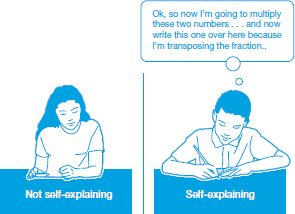
In a correlational study (that is, there was no experimental manipulation here), researchers found that college students who engaged in self-explanation while trying to solve physics problems showed better understanding of the concepts on a later test (Chi, Bassok, Lewis, Reimann, & Glaser, 1989). However, the correlation between self-explanation and better understanding of the concepts on a test does not tell us that self-explanation causes better understanding (see Chapter 2). It could be that self-explaining leads to better performance on a test, but it could also be that better understanding of the material leads to both greater self-explanation and greater test performance. There could also be other factors that influence both self-explanation and test performance. (see p. 442 of Chi, de Leeuw, Chui, & LaVancher, 1994). The correlation tells us that the two are related, but does not tell us how they are related.
In order to determine causality, we need a true experiment. In a true experiment, random assignment is used and a variable (or multiple variables) is manipulated. Then, the outcome is measured and the researcher looks for differences caused by the manipulation. Once Chi and colleagues found the correlation between self-explanation and better understanding of the concepts, the next step was a true experiment.
In a follow-up study (Chi et al., 1994), the researchers specifically prompted one group of students to self-explain, while the other group were left to do whatever they normally did (some self-explained, while others didn’t). Because they randomly assigned students to be prompted to self-explain or not, this study represents a true experiment. The experimental group who were prompted to self-explain performed significantly better than the control group on a later test of understanding, suggesting self-explanation itself does lead to greater performance on a test later. Similar results were found with elementary school students learning to solve word problems in math, with better performance in the self-explanation group on both an immediate test and a test one month after initial study (Tajika, Nakatsu, Nozaki, Neumann, & Maruno, 2007).
One interesting application of the self-explanation method is the prepare-to-teach method, where you end up learning the material really well because you have to get good enough to be able to teach it to someone else. In fact, even just expecting to have to teach the material, without actually teaching it, produces great learning gains over preparing for a test (Nestojko, Bui, Kornell, & Bjork, 2014)!
Abstract ideas can be vague and hard to grasp, and humans are better able to remember concrete information than abstract information (Paivio, Walsh, & Bons, 1994). As such, concrete examples of abstract ideas can be very helpful for understanding and remembering information.
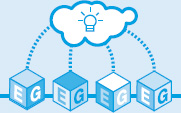
Concrete examples help illustrate abstract ideas and make them easier to understand.
Take “scarcity” as an example of an abstract idea. Scarcity can be explained as follows: the rarer something is, the higher its value will be. But this description contains a lot of vague terms, such as “rarer” and “value.” How can we make this idea more concrete? We could use a specific example to illustrate the idea.
Think about an airline company. If you were to try to book a flight four months in advance, the ticket prices would probably be pretty reasonable. But as it gets closer to the date of travel, there will be fewer seats left on the plane (the seats are rarer). This scarcity drives up the cost (value) of the tickets. This is a concrete example of scarcity, which is an abstract idea.
Providing examples seems easy enough – and we probably all do it when we teach – but one potential problem is that students may remember the concrete example, but not remember the underlying abstract idea. In other words, students might just remember the surface details of the example and not remember the links to the underlying concept the instructor was trying to teach. (Or, possibly they never really understood the links to begin with.) We have a concrete example of this concept (pun intended).
When I (Megan) was in graduate school, the first class I taught solo was a hybrid section of Introduction to Psychology. As a way to demonstrate positive reinforcement to the class, I decided to bring in candy. I used the candy as a positive reinforcement for class participation, and (thankfully) was able to increase students’ participation by giving them candy in the class. The demonstration seemed to work well in the moment.
However, at the end of the semester, when I received my course evaluations, many of the students said “I liked her class, she gave us candy.” Part of me was stunned. Why didn’t they realize that the candy was used to demonstrate a principle? I suppose I shouldn’t have been surprised. My students remembered the surface details of the example, (i.e., there was candy) without remembering the underlying structure (i.e., positive reinforcement, for example with candy, can be used to increase a behavior, for example participation).
There is a plethora of research showing that students often notice and remember the surface details of an example rather than the underlying structure, especially as novices. For example, physics experts are able to extract underlying structure from problems to sort them into categories, while physics novices tended to sort problems by surface details (Chi, Feltovich, & Glaser, 1981; see Smith [2016] for a blog post describing this study).
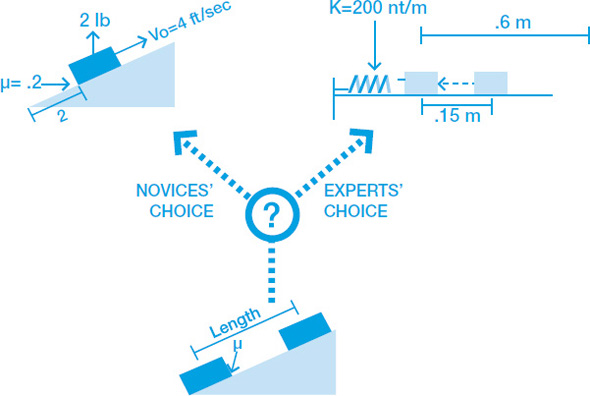
Students seem to have trouble ignoring the surface details and focusing on the underlying structure of examples. This is especially problematic when students need to transfer what they are learning from one example to another – an important goal for education! Gick and Holyoak (1980) examined whether college students could use one problem to solve another analogous problem. First, the students read a story about a general trying to capture a fortress:
A small country was ruled from a strong fortress by a dictator. The fortress was situated in the middle of the country, surrounded by farms and villages. Many roads led to the fortress through the countryside. A rebel general vowed to capture the fortress. The general knew that an attack by his entire army would capture the fortress. He gathered his army at the head of one of the roads, ready to launch a full-scale direct attack. However, the general then learned that the dictator had planted mines on each of the roads. The mines were set so that small bodies of men could pass over them safely, since the dictator needed to move his own troops and workers to and from the fortress. However, any large force would detonate the mines. Not only would this blow up the road, but it would also destroy many neighboring villages. It seemed impossible to capture the fortress. However, the general devised a simple plan. He divided his army into small groups and dispatched each group to the head of a different road. When all was ready, he gave the signal and each group marched down a different road. Each group continued down its road to the fortress, so that the entire army arrived together at the fortress at the same time. In this way, the general captured the fortress and overthrew the dictator.
Then, after a few minutes, the students were given a couple of problems to solve, including a problem analogous to the fortress problem:
Suppose you are a doctor faced with a patient who has a malignant tumor in his stomach. To operate on the patient is impossible, but unless the tumor is destroyed, the patient will die. A kind of ray, at a sufficiently high intensity, can destroy the tumor. Unfortunately, at this intensity, the healthy tissue that the rays pass through on the way to the tumor will also be destroyed. At lower intensities the rays are harmless to the healthy tissue, but will not affect the tumor.
How can the rays be used to destroy the tumor without injuring the healthy tissue?
The problems have very different surface details. One includes a general, an army, a fortress, roads, and mines, while the other includes a patient, a doctor, a tumor, radiation, and healthy tissue. Yet they both have the same underlying structure, and the solution presented in the fortress problem – break up a large force into smaller forces to converge in the middle – can be used to solve the tumor problem.
However, across a number of experiments, few students were able to spontaneously transfer the solution from one problem to the next. In one of their experiments, only 20 percent of students spontaneously solved the tumor problem using the analogous general problem. This is surprising because the two problems were presented during the same experimental session! When students were given a hint – “In solving this problem you may find that one of the stories you read before will give you a hint for a solution of this problem” – many more solved the problem (92 percent), but this means with an explicit hint 8 percent of students still could not make the connection between the two examples. Certainly, the hint scenario is not practical; how many students have a teacher following them throughout their lives giving them hints about when to apply various things they have learned?
Providing concrete examples can help students understand abstract ideas, but when teaching novices we run the risk of students remembering the surface details of the example, which isn’t as important as remembering and understanding the abstract ideas themselves. Selectively remembering only the surface details will make it extremely difficult for students to then notice and apply the abstract idea when they come across a different relevant example. One way of trying to help students understand the underlying idea is to provide students with multiple examples (Gick & Holyoak, 1983). This will be especially helpful if the various examples have different surface details.


It is important to use multiple concrete examples to illustrate abstract concepts.
Take the example of scarcity from earlier in the chapter. We provided one example about buying tickets for an airline. But later, what if the students remember that what they learned had something to do with planes, but don’t remember anything else? They will have missed the point of the concrete example. To help alleviate this, we could also provide an example about ticket sales for sports games. Well before the season starts tickets are more plentiful and are often less expensive. However, as the sports season progresses, and a team performs well, more people want to go see the team. Tickets become scarce as they sell – there are fewer seats available in the stadium – and as a result the remaining tickets become more expensive. This provides another concrete example of scarcity, but this example still has some surface details in common with the first example. Students may think that scarcity has to do with ticket sales, whether for an airline or a sports game, but nothing else.
Finally, consider another very different example. In dry areas if there is a drought, then water, a natural resource, becomes scarce. In these situations, the value placed on water is higher. It can be more expensive to purchase water, and due to the lack of resources the city may even put restrictions on how much water each household is allowed to use in a given day or week. Now the value of every drop of water we use becomes greater, and we will be less likely to want to waste water on things we don’t need – a drought is probably not the best time for a water balloon fight or to fill the pool – and save the water for times when we really need it, like drinking, bathing, and cooking.
The water in a drought concrete example still demonstrates the abstract idea of scarcity, but has different surface details from the airline tickets and sports game tickets examples. While the first two dealt with money and tickets, the third example is about natural resources and saving. Providing this type of range of concrete examples makes it more likely that students will be able to look past the surface details, and understand the abstract idea. To read more about why providing multiple examples is important, you can read a guest post on our blog by Althea Bauernschmidt (Bauernschmidt, 2017).
It is important to note that concrete examples do not always improve learning. In some cases, concrete examples such as physical manipulatives (i.e., objects that are used to demonstrate an abstract concept) can actually impede learning. This can happen if manipulatives are too fun to play with, thereby driving attention (see Chapter 6) away from the learning task; or if the surface features of the concrete examples are too salient, driving attention away from the abstract concept they are supposed to represent (McNeil, Uttal, Jarvin, & Sternberg, 2009).
Vivid concrete examples can actually reduce transfer in some cases, because the learner becomes so fixated on the specific features of the concrete example that they can’t see the connection to the abstract idea and other examples (Carbonneau, Marley, & Selig, 2013). Overall, making connections from concrete examples to abstract ideas is difficult for those with less knowledge of the subject at hand, and instructors need to make these connections explicit for learners.
Dual coding is the process of combining verbal materials with visual materials. Pictures are often remembered better than words (Paivio & Csapo, 1969; 1973). Dual coding theory is the idea that when we combine text information and visual information, our learning is enhanced because we process verbal and visual information through separate channels (Paivio, 1971; 1986).
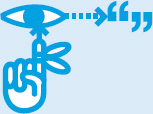
Pictures are generally remembered better than words, and can provide an additional memory cue.
The idea is that when you have the same information in two formats – words and visuals – this gives you two ways of remembering the information later on.
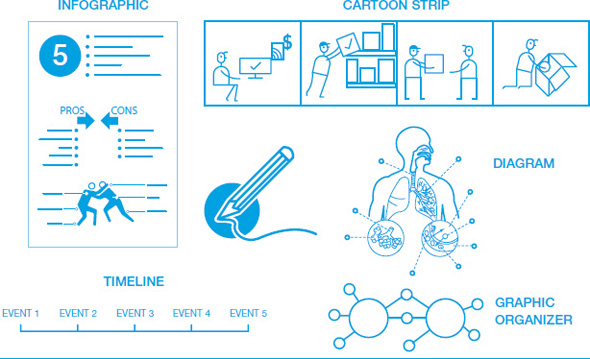
There are many ways to visually represent material, such as with infographics, timelines, cartoon strips, diagrams, and graphic organizers.
Because dual coding involves presenting information in visual and verbal form, it can start to sound like we are talking about learning styles. We already discussed misunderstandings around learning styles in Chapter 4, and noted that there is a great deal of research showing that assessing learning style and then matching instruction to style does not improve learning (see Pashler, McDaniel, Rohrer, & Bjork, 2008). We all have preferences, sure – but matching instruction to these preferences does not lead to improved learning.
Instead, dual coding suggests that, regardless of preferences, students tend to learn better when you combine modalities. For example, let’s say we have a student who states that they prefer diagrams and actually need diagrams in order to learn. (Anecdotally, a lot of our students tend to tell us that they’re visual learners, and thus learn best from the pictures.) The learning styles theory (Dunn, 2000) would suggest that we should only give additional visual representations to these students, whereas other students who are more verbal should get additional verbal explanations. Yet, according to dual coding theory, we should give ALL students a relevant diagram and relevant verbal information to go along with it, and encourage the students to integrate the two.
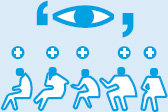
Combining pictures with words can be helpful for all learners – not just those who like pictures.
If students are learning about the anatomy of an animal cell, giving them a diagram with no words on it at all will not likely help them with the anatomy (though there is an exception, which we will get to in the next paragraph). But, giving them a diagram that is labeled and explains how the different components of the cell work together is much more likely to be beneficial.
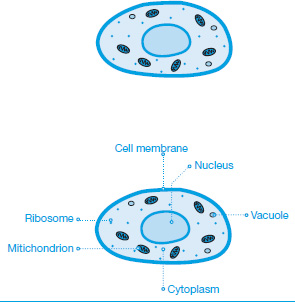
Examples of an unlabeled and labeled diagram
There is one exception we can think of where an unlabeled diagram might actually be more helpful. If the students already understand how the different aspects of the animal cell work together, they could use the unlabeled diagram to practice retrieval of the various pieces, and how they all work together. In this case, the students would be combining dual coding (visual information with verbal information), elaborative interrogation (describing and explaining how things work), and retrieval practice (bringing information to mind, see Chapter 10).
The idea of dual coding often appears as multimedia learning, because here the material is represented in multiple forms (Meyer & Anderson, 1992). However, as with most things in life, there’s always a risk of “too much of a good thing.” One problem is that sometimes, the visuals we choose might not be all that relevant to the content being studied. In these cases, visuals may do nothing to help learning, and even worse, might actually hurt learning by producing irrelevant but appealing distractions known in the literature as “seductive details” (Harp & Mayer, 1997).
Another problem is that sometimes combining too many words and visuals can actually hurt learning. Too much information at once can lead to cognitive overload (see Chapter 6), where “the learner’s intended cognitive processing exceeds the learner’s available cognitive capacity” (Mayer & Moreno, 2003, p. 43). If the demands of a learning activity require too much cognitive capacity, then students will not fully benefit from the activity.
Thus, presenting information to students as words and visuals can help them learn, and learn in a meaningful way. However, if a student experiences cognitive overload trying to process all of the information in a meaningful way, then dual coding can harm learning. For example, the placing of labels in a diagram is important. That is, if labels are not placed conveniently near the aspects that are being labeled, this can create undesirable cognitive load and potentially impede learning (Mayer & Moreno, 2003) (see over).
But, cognitive overload is not specifically a problem with dual coding; cognitive overload can be an obstacle in almost all learning situations. Just because dual coding can lead to cognitive overload doesn’t mean it has to. For some general suggestions about how to reduce cognitive load when using dual coding learning strategies, see Chapter 11: Tips for teachers.
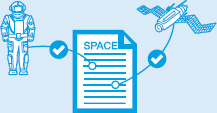
Any pictures accompanying written material must be relevant to target concepts.
Understanding can be developed through a process called elaboration, which involves connecting new information to pre-existing knowledge and describing things in many details. In practice, elaboration could mean many different things, but the common thread is that elaboration involves adding features to existing memories. In this chapter, we discuss three specific techniques that can be used to encourage elaboration. (1) Elaborative interrogation involves students asking “how” and “why” questions about the concepts they are studying, and then trying to answer these questions. (2) Concrete examples can provide several advantages to the learning process: (a) they can concisely convey information, (b) they can provide students with more concrete information that is easier to remember, and (c) they can take advantage of the superior memorability of pictures relative to words. Finally, (3) dual coding theory suggests that providing both verbal and pictorial representations of the same information enhances learning and memory. Given that pictures are generally remembered better than words, it is important to ensure that the pictures students are provided with are helpful and relevant to the content they are expected to learn.
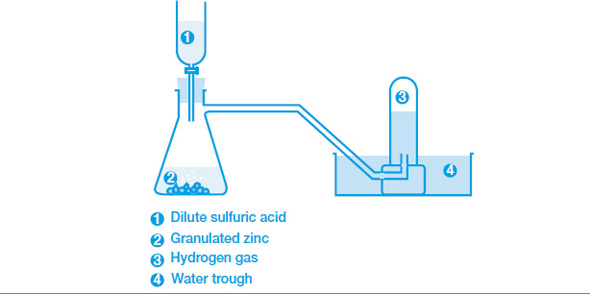
Labels are placed far away from the aspects being labeled
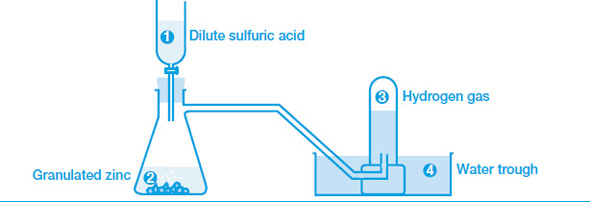
Labels are placed near the aspects being labeled
Anderson, J. R. (1983). A spreading activation theory of memory. Journal of Verbal Learning and Verbal Behavior, 22, 261–295.
Bauernschmidt, A. (2017, May). Two examples are better than one [Blog post]. The Learning Scientists Blog. Retrieved from www.learningscientists.org/blog/2017/5/30-1
Bellezza, F. S., Cheesman, F. L., & Reddy, B. G. (1977). Organization and semantic elaboration in free recall. Journal of Experimental Psychology: Human Learning and Memory, 3, 539–550. doi:10.1037/0278-7393.3.5.539
Carbonneau, K., Marley, S. C., & Selig, J. P. (2013). A meta-analysis of the efficacy of teaching mathematics with concrete manipulatives. Journal of Educational Psychology, 105, 380–400.
Chi, M. T., Feltovich, P. J., & Glaser, R. (1981). Categorization and representation of physics problems by experts and novices. Cognitive Science, 5, 121–152.
Chi, M. T., de Leeuw, N., Chiu, M. H., & LaVancher, C. (1994). Eliciting self-explanations improves understanding. Cognitive Science, 18, 439–477.
Chi, M. T., Bassok, M., Lewis, M. W., Reimann, P., & Glaser, R. (1989). Self-explanations: How students study and use examples in learning to solve problems. Cognitive Science, 13, 145–182.
Clinton, V., Alibali, M. W., & Nathan, M. J. (2016). Learning about posterior probability: Do diagrams and elaborative interrogation help? The Journal of Experimental Education, 84, 579–599.
Craik, F. I., & Lockhart, R. S. (1972). Levels of processing: A framework for memory research. Journal of Verbal Learning and Verbal Behavior, 11, 671–684.
Craik, F. I., & Tulving, E. (1975). Depth of processing and the retention of words in episodic memory. Journal of Experimental Psychology: General, 104, 268–294.
Dunn, R. (2000). Learning styles: Theory, research, and practice. National Forum of Applied Educational Research Journal, 13, 3–22.
Gick, M. L., & Holyoak, K. J. (1980). Analogical problem solving. Cognitive Psychology, 12, 306–355.
Gick, M. L., & Holyoak, K. J. (1983). Schema induction and analogical transfer. Cognitive Psychology, 15, 1–38.
Harp, S. F., & Mayer, R. E. (1997). The role of interest in learning from scientific text and illustrations: On the distinction between emotional interest and cognitive interest. Journal of Educational Psychology, 89, 92–102.
Hirshman, E. (2001). Elaboration in memory. In N. J. Smelser & P. B. Baltes (Eds.), International encyclopedia of the social and behavioral sciences (pp. 4369–4374). Oxford: Pergamon.
Kahl, B., & Woloshyn, V. E. (1994). Using elaborative interrogation to facilitate acquisition of factual information in cooperative learning settings: One good strategy deserves another. Applied Cognitive Psychology, 8, 465–478.
Karpicke, J. D., & Smith, M. A. (2012). Separate mnemonic effects of retrieval practice and elaborative encoding. Journal of Memory and Language, 67, 17–29.
Mandler, G. (1979). Organization and repetition: Organizational principles with special reference to rote learning. In L. G. Nillson (Ed.), Perspectives on memory research (pp. 293–327). Hillsdale, NJ: Lawrence Erlbaum Associates.
Mayer, R. E., & Moreno, R. (2003). Nine ways to reduce cognitive load in multimedia learning. Educational Psychologist, 38, 43–52.
McDaniel, M. A., & Donnelly, C. M. (1996). Learning with analogy and elaborative interrogation. Journal of Educational Psychology, 88, 508–519.
McNeil, N. M., Uttal, D. H., Jarvin, L., & Sternberg, R. J. (2009). Should you show me the money? Concrete objects both hurt and help performance on mathematics problems. Learning and Instruction, 19, 171–184.
Meyer, R. E., & Anderson, R. B. (1992). The instructive animation: Helping students build connections between words and pictures in multimedia learning. Journal of Educational Psychology, 4, 444–452.
Nestojko, J. F., Bui, D. C., Kornell, N., & Bjork, E. L. (2014). Expecting to teach enhances learning and organization of knowledge in free recall of text passages. Memory & Cognition, 42, 1038–1048.
Paivio, A. (1971). Imagery and verbal processes. New York: Holt, Rinehart and Winston.
Paivio, A. (1986). Mental representations: A dual coding approach. New York: Oxford University Press.
Paivio, A., & Csapo, K. (1969). Concrete image and verbal memory codes. Journal of Experimental Psychology, 80, 279–285.
Paivio, A., & Csapo, K. (1973). Picture superiority in free recall: Imagery or dual coding? Cognitive Psychology, 5, 176–206.
Paivio, A., Walsh, M., & Bons, T. (1994). Concreteness effects on memory: When and why? Journal of Experimental Psychology: Learning, Memory, and Cognition, 20, 1196–1204.
Pashler, H., McDaniel, M., Rohrer, D., & Bjork, R. (2008). Learning styles concepts and evidence. Psychological Science in the Public Interest, 9, 105–119.
Postman, L. (1976). Methodology of human learning. In W. K. Estes (Ed.), Handbook of learning and cognitive processes: Volume 3, Approaches to human learning and motivation (pp. 11–69). Hillsdale, NJ: Lawrence Erlbaum Associates.
Pressley, M., McDaniel, M. A., Turnure, J. E., Wood, E., & Ahmad, M. (1987). Generation and precision of elaboration: Effects on intentional and incidental learning. Journal of Experimental Psychology: Learning, Memory, and Cognition, 13, 291–300.
Smith, B. L., Holliday, W. G., & Austin, H. W. (2010). Students’ comprehension of science textbooks using a question-based reading strategy. Journal of Research in Science Teaching, 47, 363–379.
Smith, M. A. (2014). The process of elaboration and implications for retrieval processes (Doctoral dissertation). Retrieved from ProQuest Dissertations and Theses database. (UMI No. 3669553).
Smith. M. (2016, October). What do students remember from our examples? [Blog post]. The Learning Scientists Blog. Retrieved from: www.learningscientists.org/blog/2016/10/20-1
Tajika, H., Nakatsu, N., Nozaki, H., Neumann, E., & Maruno, S. (2007). Effects of self-explanation as a metacognitive strategy for solving mathematical word problems. Japanese Psychological Research, 49, 222–233.
Woloshyn, V. E., & Stockley, D. B. (1995). Helping students acquire belief-inconsistent and belief-consistent science facts: Comparisons between individual and dyad study using elaborative interrogation self-selected study and repetitious-reading. Applied Cognitive Psychology, 9, 75–89.
Woloshyn, V. E., Pressley, M., & Schneider, W. (1992). Elaborative-interrogation and prior-knowledge effects on learning of facts. Journal of Educational Psychology, 8, 115–123.